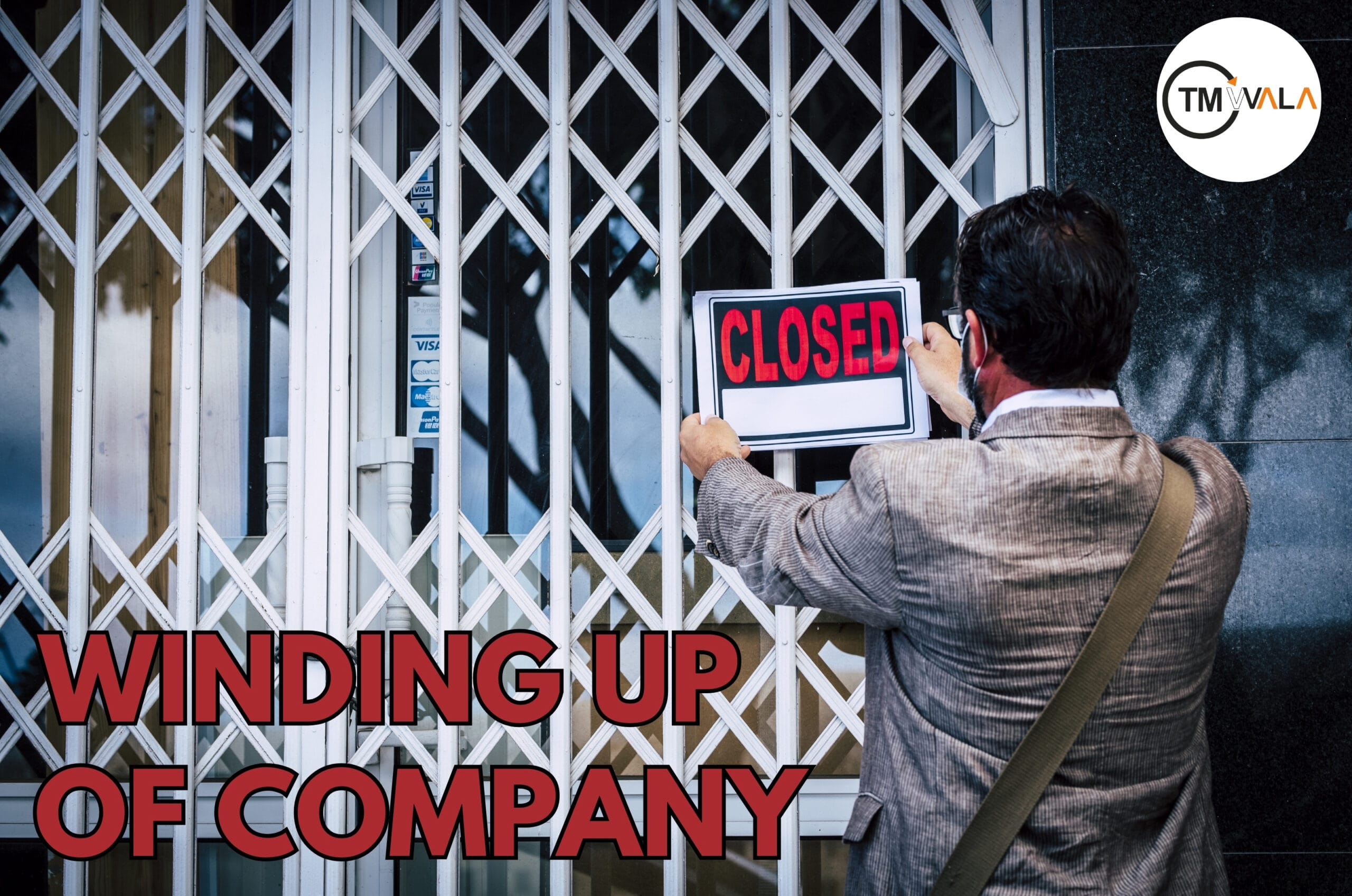Introduction
Company winding up, also known as liquidation, is the formal process by which a business ends its operations and is dissolved. It involves the methodical closing of the business’s affairs, which includes selling assets, using the proceeds to pay off debts, and distributing any remaining surplus to shareholders based on their ownership stake. The winding up process can be started by a court order or by a voluntary resolution adopted by the business. At the conclusion of the winding-up proceedings, the business is formally dissolved and ceases to exist, signifying the end of its corporate existence through this legal procedure.
What is the Winding Up of a Company?
As defined by Section 2(94A) of the Companies Act, 2013, “winding up” means the official procedure of closing a company through the mechanisms made available by the Companies Act or by going through liquidation under the Insolvency and Bankruptcy Code, 2016. This procedure entails stopping regular business operations, selling off assets, and paying off debts in order to finally dissolve the company. In the interim, the company retains its legal status and is still able to engage in litigation before a Tribunal. The goal of winding up is to guarantee an orderly closure and distribution of the company’s assets.
Benefits of winding up
- Proper Process and Compliance: Winding up makes sure that the procedure complies with applicable laws and acts by ensuring it does so by the law.
- Steer clear of legal issues: Directors may make suggestions to keep the firm afloat, and if the right procedures are followed, they may also be able to prevent the tribunal or court from taking legal action. This enables the corporation to concentrate on potential new ventures.
- Economically Sound: In general, the winding-up process is less expensive than other court cases.
- Creditor Protection: Adequate winding-up protocols provide protection to creditors. To guarantee that their rights are respected, their claims are prioritized and safeguarded accordingly.
- Lease Agreement Cancellation: As part of the liquidation process, all current leases and contracts are cancelled.
Types of winding up of a company
There are two primary methods for ending a business:
- Winding Up by Tribunal: This happens when the winding-up procedure involves other parties, including creditors. Sections 270 and 271 of the CA 2013 allow a creditor’s voluntary winding up to become a tribunal-based winding up.
- Voluntary Winding Up: Started by a board resolution and company participants. This kind is separated further into:
- Members’ Voluntary Winding Up: When the business can pay its debts and is solvent.
- Voluntary Winding Up of Creditors: When an organization is insolvent and unable to settle its debts.
Grounds for winding up
Here are the grounds for winding up a company:
- Inability to Pay Debts: The tribunal may wind up a company if it deems the company unable to pay its debts, as outlined in section 271(2) of the CA 2013.
- Special Resolution: If the company passes a special resolution to wind up its affairs.
- National Interest: If the company acts against India’s sovereignty, integrity, or friendly relations with foreign countries.
- Sick Company: If the tribunal finds the company to be sick under Chapter 19.
- Fraudulent or Unlawful Purpose: If the company has engaged in fraudulent or unlawful activities, a complaint can trigger winding up.
- Failure to File Returns: Regularly defrauding or failing to file annual returns can be grounds for winding up.
- Just and Equitable: If the tribunal believes it is fair and just to wind up the company.
Voluntary Winding Up of a Company
The company’s members initiate the voluntary winding up process; the court is not involved. It might start in one of two primary ways:
- By Special Resolution: To wind up, the members unanimously decide to enact a special resolution dissolving the corporation.
- By the Articles of Association’s Expiration or Event: The corporation is voluntarily wound up when its predetermined period of time runs out or something specified in the Articles of Association happens that necessitates dissolution.
Documents Required for Voluntary Winding Up of a Company
For the voluntary winding up of a company, the following documents are required:
- Special Resolution (Form-26): Proof of the company’s decision to wind up, passed by the members.
- Declaration of Solvency (Form 107): A statement confirming the company’s ability to pay its debts.
- Directors’ Affidavit: A sworn statement affirming the accuracy of financial documents, including the auditor’s report and accounts up to the latest date before declaring solvency.
- Liquidator’s Consent: Agreement from the appointed liquidator to manage the winding-up process.
- Notice of Winding Up Resolution: A notice published in the Official Gazette about the decision to wind up.
- Notice of Liquidator Appointment: A notice published in the Official Gazette announcing the liquidator’s appointment.
- Preliminary Liquidator’s Report: An initial report from the liquidator detailing the winding-up plan.
- Final Liquidator’s Report and Accounts: The liquidator’s final comprehensive report and financial statements, presented at the last shareholders’ meeting.
- Notice of Final Meeting: Announcement of the company’s concluding gathering.
- Meeting Return: Documentation of the final report, accounts, and meeting minutes submitted to the company registration office.
Procedure of winding up a company
- File a Petition: Interested parties (trade creditors, the company itself, contributories, or government authorities) file a petition for winding up. Use Form WIN 1 or WIN 2, in triplicate, with an affidavit in Form WIN 3.
- Statement of Affairs: Along with the petition, provide the Statement of Affairs in Form WIN 4, up to date within 30 days. Submit it in duplicate with an affidavit in Form WIN 5.
- Advertisement: Advertise the petition in English and a local language for 14 days before the hearing, using Form WIN 6.
- Appointment of Provisional Liquidator: After submitting the petition, the tribunal appoints a provisional liquidator. Notify the company using Form WIN 7, detailing responsibilities in Form WIN 8.
- Notify the Provisional Liquidator: The registrar sends a notice to the official liquidator using Form WIN 9 within 7 days of the order.
- Winding Up Order: The winding-up order, in Form WIN 11, is sent to the company within 7 days, along with Forms WIN 12 and 13.
- Custody of Property: The liquidator takes custody of all assets, documents, and books. A report must be submitted to the tribunal within 60 days.
- Affairs of the Company: The liquidator applies to the tribunal for dissolution if deemed just and reasonable. Forward the dissolution order to the registrar within 30 days.
- Dissolving the Company: The tribunal dissolves the company within 60 days of receiving the application if the accounts are in order.
Legal liabilities
Here’s a concise overview of penalties for non-compliance during the winding-up of a company:
- Sec 284 – Failure to cooperate with the liquidator:
- Penalty: Up to INR 50,000 or 6 months imprisonment, or both.
- Sec 302 – Default by the liquidator in forwarding a copy of the order:
- Penalty: INR 5,000 per day of default.
- Sec 305 – False declaration of solvency:
- Penalty: INR 50,000 to 3 Lakhs, or up to 3 years imprisonment, or both.
- Sec 306 – Failure to call or conduct creditors’ meetings:
- Penalty: INR 50,000 to 2 Lakhs, or up to 6 months imprisonment, or both.
- Sec 307 – Failure to publish notice of the resolution:
- Penalty: INR 5,000 per day of default.
- Sec 312 – Failure to notify the registrar of liquidator appointment/vacancy:
- Penalty: INR 500 per day of default.
- Sec 314 – Failure to file audited quarterly statements:
- Penalty: INR 5,000 per day of default, up to INR 10 Lakhs.
- Sec 316 – Failure to report on winding-up progress:
- Penalty: Up to INR 10 Lakhs.
- Sec 318 – Failure to comply with final meeting and dissolution provisions:
- Penalty: Up to INR 1 Lakh.
- Sec 336 – False representation or fraud:
- Penalty: INR 1 Lakh to 3 Lakhs, and/or 3 to 5 years imprisonment.
- Sec 337 – Penalty for frauds by officers when winding up is ordered:
- Penalty: INR 1 Lakh to 3 Lakhs, and/or 1 to 3 years imprisonment.
- Sec 338 – Liability for improper accounting:
- Penalty: INR 1 Lakh to 3 Lakhs, and/or 1 to 3 years imprisonment.
- Sec 339 – Fraudulent business practices:
- Penalty: Up to 3 times the fraud amount, with 6 months to 10 years imprisonment (3 years if public interest is involved).
- Sec 342 – Failure to assist in prosecution:
- Penalty: INR 25,000 to 1 Lakh.
- Sec 344 – Failure to publish winding-up statement on documents:
- Penalty: INR 50,000 to 3 Lakhs.
- Sec 347 – Contravening disposal orders of company books:
- Penalty: Up to INR 50,000 or 6 months imprisonment, or both.
- Sec 348 – Incorrect information about pending litigations:
- Penalty: Up to INR 1 Lakh or INR 5,000 per day of default.
- Sec 356 – Failure to file a certified copy regarding void dissolution:
- Penalty: INR 10,000 per day of default.
These penalties ensure adherence to legal requirements and safeguard the winding-up process’s integrity.
“TMWALA” is here to help!!!
“TMWALA” is an expert in helping businesses wind up. They have a thorough understanding of the legal requirements under the Companies Act and the Insolvency and Bankruptcy Code, so from the beginning of petitions and managing creditors to the end of the process, “TMWALA” guarantees precise compliance. Their experience includes all types of winding up, including voluntary, tribunal-led, and creditor-based, and they offer customized strategies to safeguard the rights of creditors, manage assets, and smoothly navigate legal complexities. Whether obtaining court approvals, overseeing financial disclosures, or making sure timely filings, “TMWALA” simplifies the winding-up process, protecting client interests with accuracy and efficiency.
Important FAQs
- What is the primary purpose of winding up a company?
Ans. Winding up a company aims to close the business formally by stopping operations, selling assets, paying off debts, and distributing any remaining surplus to shareholders. It ensures an orderly closure and distribution of assets, ultimately leading to the dissolution of the company.
- What are the key differences between voluntary winding up and winding up by a tribunal?
Ans.
- Voluntary Winding Up: Initiated by the company’s members through a special resolution or expiration of a predetermined period. It is typically used when the company is solvent or insolvent but voluntarily decides to close.
- Winding Up by Tribunal: Ordered by a tribunal or court, often due to insolvency or legal issues, and involves creditors or other parties. It is more formal and involves legal proceedings.
- What documents are required for a voluntary winding up?
Ans.
- Key documents include:
- Special Resolution (Form-26)
- Declaration of Solvency (Form 107)
- Directors’ Affidavit
- Liquidator’s Consent
- Notices of Winding Up Resolution and Liquidator Appointment
- Preliminary and Final Liquidator’s Reports
- Notice of Final Meeting and Meeting Return
- How long does the winding-up process typically take?
Ans. The duration of the winding-up process can vary based on the complexity of the company’s affairs and whether it is voluntary or tribunal-based. Generally, it can take several months to over a year, including time for settling all claims, asset sales, and final approvals.
- What are the penalties for non-compliance during the winding-up process?
Ans.
- Penalties for non-compliance include fines, imprisonment, or both, depending on the violation. Examples include:
- Failure to cooperate with the liquidator (up to INR 50,000 or 6 months imprisonment)
- False declaration of solvency (INR 50,000 to 3 Lakhs or up to 3 years imprisonment)
- Failure to publish necessary notices (INR 5,000 per day of default)
- Can a company still engage in legal actions during the winding-up process?
Ans. Yes, even while undergoing winding up, the company retains its legal status and can engage in litigation before a Tribunal. However, its ability to conduct regular business operations is suspended.
- What happens to the company’s leases and contracts during liquidation?
Ans. As part of the liquidation process, all existing leases and contracts are generally canceled. The liquidator will review and handle these agreements according to the company’s financial position and legal obligations.
- What role does a liquidator play in the winding-up process?
Ans. The liquidator is responsible for managing the winding-up process, including taking custody of the company’s assets, settling debts, handling legal obligations, and distributing any remaining funds to shareholders. They ensure compliance with legal requirements and oversee the orderly closure of the company.














